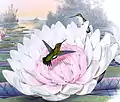Chlorostilbon
Chlorostilbon is a genus of hummingbird in the family Trochilidae, known as emeralds (as are some hummingbirds in the genera Amazilia and Elvira). A single species, the blue-chinned sapphire is variously placed in the monotypic genus Chlorestes or in Chlorostilbon. The taxonomy of the C. mellisugus superspecies is highly complex and, depending on view, includes 1-8 species. All species in this genus have straight black or black-and-red bills. The males are overall iridescent green, golden-green or bluish-green, and in some species the tail and/or throat is blue.[1] The females have whitish-grey underparts, tail-corners and post-ocular streak.
| Chlorostilbon | |
|---|---|
 | |
| Blue-tailed emerald | |
| Scientific classification | |
| Kingdom: | Animalia |
| Phylum: | Chordata |
| Class: | Aves |
| Order: | Apodiformes |
| Family: | Trochilidae |
| Tribe: | Trochilini |
| Genus: | Chlorostilbon Gould, 1853 |
| Species | |
|
See text | |
The genus Chlorostilbon was introduced in 1853 by the English ornithologist John Gould.[2][3]
Species
The genus contains ten species:[2]
- Blue-tailed emerald (Chlorostilbon mellisugus)
- Garden emerald (Chlorostilbon assimilis)
- Red-billed emerald (Chlorostilbon gibsoni)
- Western emerald (Chlorostilbon melanorhynchus)
- Chiribiquete emerald (Chlorostilbon olivaresi)
- Glittering-bellied emerald (Chlorostilbon lucidus; formerly C. aureoventris)
- Coppery emerald (Chlorostilbon russatus)
- Narrow-tailed emerald (Chlorostilbon stenurus)
- Green-tailed emerald (Chlorostilbon alice)
- Short-tailed emerald (Chlorostilbon poortmani)
Gallery
References
- Stiles, F. Gary (1996). "A New Species of Emerald Hummingbird (Trochilidae, Chlorostilbon) from the Sierra de Chiribiquete, Southeastern Colombia, with a Review of the C. mellisugus Complex". The Wilson Bulletin. 108 (1): 1–27. ISSN 0043-5643.
- Gill, Frank; Donsker, David; Rasmussen, Pamela, eds. (July 2020). "Hummingbirds". IOC World Bird List Version 10.2. International Ornithologists' Union. Retrieved 5 January 2020.
- Gould, John (1853). A Monograph of the Trochilidae, or Family of Humming-Birds. Volume 5. London: self. Plate 355 and text (Part 5 Plate 14). The 5 volumes were issued in 25 parts between 1849 and 1861. Title pages of all volumes bear the date of 1861.

